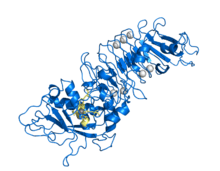Serratiopeptidase
Serratiopeptidase (Serratia E-15 protease, also known as serralysin, serrapeptase, serratiapeptase, serratia peptidase, serratio peptidase, or serrapeptidase), is a proteolytic enzyme (protease) produced by non-pathogenic enterobacterium Serratia sp. E-15, now known as Serratia marcescens ATCC 21074.[1] This microorganism was originally isolated in the late 1960s from silkworm Bombyx mori L. (intestine),[2] Serratiopeptidase is present in the silkworm intestine and allows the emerging moth to dissolve its cocoon. Serratiopeptase is produced by purification from culture of Serratia E-15 bacteria. It is a member of the Peptitase M10B (Matrixin) family.
| Serralysin | |||||||||
|---|---|---|---|---|---|---|---|---|---|
 Crystal structure of serralysin with co-ordinated zinc (grey) and calcium (white). Rendered from PDB 1SAT. | |||||||||
| Identifiers | |||||||||
| EC number | 3.4.24.40 | ||||||||
| CAS number | 70851-98-8 | ||||||||
| Databases | |||||||||
| IntEnz | IntEnz view | ||||||||
| BRENDA | BRENDA entry | ||||||||
| ExPASy | NiceZyme view | ||||||||
| KEGG | KEGG entry | ||||||||
| MetaCyc | metabolic pathway | ||||||||
| PRIAM | profile | ||||||||
| PDB structures | RCSB PDB PDBe PDBsum | ||||||||
| |||||||||
| Serratiopeptidase | |||||||
|---|---|---|---|---|---|---|---|
| Identifiers | |||||||
| Organism | |||||||
| Symbol | Spro_0210 | ||||||
| Entrez | 5605823 | ||||||
| PDB | 1SRP | ||||||
| UniProt | P07268 | ||||||
| Other data | |||||||
| EC number | 3.4.24.40 | ||||||
| |||||||
Health claims
Some alternative medicine proponents claim that serratiopeptidase is beneficial for pain and inflammation[3] but "existing trials [have been] small and generally of poor methodological quality."[4] Online medical journal Bandolier (specializing in evidence-based thinking about healthcare)[5] published an article (in about 2001) in response to a reader's enquiry about serratiopeptidase.[6] After searching PubMed and the Cochrane Library "to see if there are any randomised, controlled trials", the article stated that the "evidence on serratiopeptidase being effective for anything is not based on a firm foundation of clinical trials."[4]
The search found 34 publications in the medical databases covered, that addressed the efficacy of serratiopeptidase, of which several were found to be animal experiments, personal letters, uncontrolled trials or those with inadequate or nonexistent randomisation. The article warned against ignoring safety issues with use of biological agents.[4] No studies were found to have been conducted on the efficacy of serratiopeptidase as treatment for back pain, heart attack, stroke, or asthma. Of the 10 medical conditions with randomized-evidence studies on file in connection with serratiopeptidase, the quality or construction of the trial studies was described as "generally poor".[4][7]
In a news article published Feb 22, 2011, Kyodo News reports: "Takeda Pharmaceutical Co. said Monday it will voluntarily recall an anti-inflammatory drug touted effective for a variety of conditions ranging from chronic bronchitis to sprained ankles because recent tests have cast doubt on its efficacy even though it has been on the market for more than 40 years. Blinded experiments comparing the effects of the drug Danzen, which debuted in 1968, and placebos showed no significant differences between the two, the major drugmaker said. Sales of the product, generically called serrapeptase, totaled ¥6.7 billion in fiscal 2009, but the impact of the recall will likely be limited because similar drugs are being sold on the market, it said." .[8][9] In a case report it was seen that serratiopeptidase may cause lysis of fibrin wall around an abscess and cause its local spread. So its use sometimes could be harmful in treating abscess.(10)
See also
References
- Nakahama K, Yoshimura K, Marumoto R, Kikuchi M, Lee IS, Hase T, Matsubara H (July 1986). "Cloning and sequencing of Serratia protease gene". Nucleic Acids Res. 14 (14): 5843–55. doi:10.1093/nar/14.14.5843. PMC 311595. PMID 3016665.
- The preparation and some uses of the protease are described in US patent 3792160, Isono M, Kazutaka M, Kodama R, Tomoda K, Miyata K, "Method of treating inflammation and composition therefor", issued 1974-02-12, assigned to Takeda Chemical Industries Ltd.. The enzyme was also described by Miyata K, Maejima K, Tomoda K, Isono M (1970). "Serratia protease. Part I. Purification and general properties of the enzyme". Agricultural and Biological Chemistry. 34 (2): 310–318. and the strain of bacteria producing serratiopeptidase has been deposited with the American Type Culture Collection as strain ATCC 21074. (For online information about ATCC 21074, enter 21074 on the ATCC/LGC search page)
- Kokate CK, Purohit AP, Gokhale SB (2008). Pharmacognosy (14th ed.). Mumbai: Nirali Prakashan. p. 12.11. ISBN 81-85790-09-4.
- "Serratiopeptidase: Finding the Evidence". Bandolier online edition. Retrieved 2008-03-20.
- "Bandolier - Evidence based thinking about health care".
- The Bandolier article is undated and unsigned but the text indicates that it was written in response to a letter sent by a reader of a newspaper article that was published in 2001. No references later than 2001 are cited.
- According to Bandolier: "Studies were small, outcomes were poorly defined, and in some, different medical conditions were mixed. Five studies were described as double blind: one was completely uninterpretable, three methodologically weak studies were positive, and one trial of apparent high quality was negative. This latter study compared serratiopeptidase, serraprose S or placebo in the treatment of chronic respiratory disease, with about 120 patients per group, and found no significant difference between groups for any outcome."- Bandolier, "Serratiopeptidase - Finding the Evidence"
- "'68 Takeda pain drug pulled, useless - The Japan Times". The Japan Times.
- "HSA Updates on the Phasing-Out of Serratiopeptidase-Containing Preparations as Medicinal Products". HSA Updates. Singapore: Health Sciences Authority. November 29, 2011. Retrieved May 26, 2020.